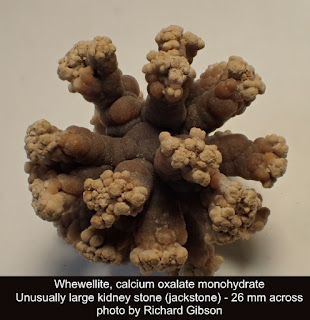April 10, 2018
This episode is about some of the interesting connections that arise in science.
We’ll start with me and my first professional job as a
mineralogist analyzing kidney stones. My mineralogy professor at Indiana
University, Carl Beck, died unexpectedly, and his wife asked me as his only
grad student to carry on his business performing analysis of kidney stones. Beck
had pioneered the idea of crystallographic examination to determine mineralogy
of these compounds because traditional chemical analysis was misleading. For example,
some common kidney stones are chemically calcium phosphates and calcium
carbonates – but they are hardly ever calcium carbonate minerals. That makes a
big difference in terms of treatment, because calcium carbonate minerals can be
dissolved with acids, while calcium phosphate cannot. The carbonate is actually
part of the phosphate mineral structure, partially substituting for some of the
phosphate. Other subtleties of mineral crystallography can distinguish between different
minerals and can point to specific kinds of treatments, more than just
chemistry can.
One of the most common minerals in kidney stones is called
whewellite – calcium oxalate, CaC2O4 with a water molecule as part of its structure.
In kidney stones it usually forms little rounded blobs, but sometimes the way
the mineral grows, it makes pointy little things called jackstones, for their
similarity to children’s’ jacks. And yes, those can be awfully painful, or so I’m
told. Whewellite is really rare in the
natural world beyond the urinary system, but it does exist, especially in
organic deposits like coal beds. Whewellite was named for William Whewell,
spelled Whewell, a true polymath and philosopher at Cambridge University in
England during the first half of the 19th century. He won the Royal
Medal for his work on ocean tides and published studies on astronomy,
economics, physics, and geology, and was a professor of mineralogy as well.

 .css-j9qmi7{display:-webkit-box;display:-webkit-flex;display:-ms-flexbox;display:flex;-webkit-flex-direction:row;-ms-flex-direction:row;flex-direction:row;font-weight:700;margin-bottom:1rem;margin-top:2.8rem;width:100%;-webkit-box-pack:start;-ms-flex-pack:start;-webkit-justify-content:start;justify-content:start;padding-left:5rem;}@media only screen and (max-width: 599px){.css-j9qmi7{padding-left:0;-webkit-box-pack:center;-ms-flex-pack:center;-webkit-justify-content:center;justify-content:center;}}.css-j9qmi7 svg{fill:#27292D;}.css-j9qmi7 .eagfbvw0{-webkit-align-items:center;-webkit-box-align:center;-ms-flex-align:center;align-items:center;color:#27292D;}
.css-j9qmi7{display:-webkit-box;display:-webkit-flex;display:-ms-flexbox;display:flex;-webkit-flex-direction:row;-ms-flex-direction:row;flex-direction:row;font-weight:700;margin-bottom:1rem;margin-top:2.8rem;width:100%;-webkit-box-pack:start;-ms-flex-pack:start;-webkit-justify-content:start;justify-content:start;padding-left:5rem;}@media only screen and (max-width: 599px){.css-j9qmi7{padding-left:0;-webkit-box-pack:center;-ms-flex-pack:center;-webkit-justify-content:center;justify-content:center;}}.css-j9qmi7 svg{fill:#27292D;}.css-j9qmi7 .eagfbvw0{-webkit-align-items:center;-webkit-box-align:center;-ms-flex-align:center;align-items:center;color:#27292D;}